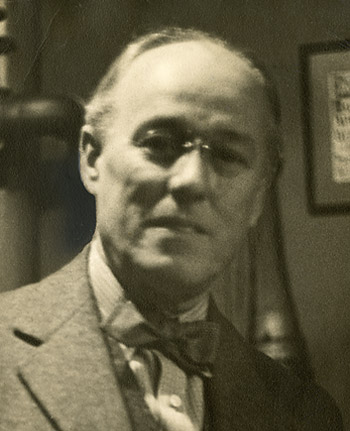Deerfield Arts & Crafts home page
People
Augustus V. Tack
1870-1949

© Memorial Hall Museum, Pocumtuck Valley Memorial Association
August Vincent Tack, by unknown photographer, date unknown.
Nationally-recognized portrait and landscape painter Augustus Vincent Tack connected the Deerfield Arts and Crafts movement to the interests and concerns of the larger art world. Tack, like Ellen Miller and Margaret Whiting, had studied at the Art Students League in New York City. In 1900 he married Agnes Gordon Fuller, the daughter of Deerfield, Massachusetts painter George Fuller, and moved to Deerfield. Augustus Vincent Tack eventually lived in Deerfield, New York, and Washington, where he distinguished himself as a portraitist, muralist, and eventually as an abstract painter. Tack organized the first of many painting exhibitions in 1899 that hung in the Harrow studios (owned by Margaret Whiting and located behind her home) and timed to coincide with Deerfield's handicraft exhibitions.
In the summer of 1901, Augustus Vincent Tack was appointed as one of three founding advisory board members of the Deerfield Society of Arts and Crafts, and in the coming years, the painter consistently shared his talents with the crafters of Deerfield. He served on the Society's jury, and, perhaps most importantly, introduced Deerfield artisans to Japanese art as a design source. At a November 1906 Deerfield Industries meeting "Mr. Tack gave a very interesting talk on the general principals of Art and design and used some Japanese prints and textiles to illustrate the beautiful considerations of color which could be obtained. A general feeling of pleasure was expressed at the helpfulness of Mr. Tack's talk."1 The artist was later asked to acquire a set of Japanese prints so Society of Deerfield Industries members could study color and harmony. Noting that craftsmen "can never go far astray if they follow Japanese influence," the Boston Evening Transcript (February 9, 1907) commended the Society for following Tack's advice.
- Deerfield Industry Minutes, PVMA Library.